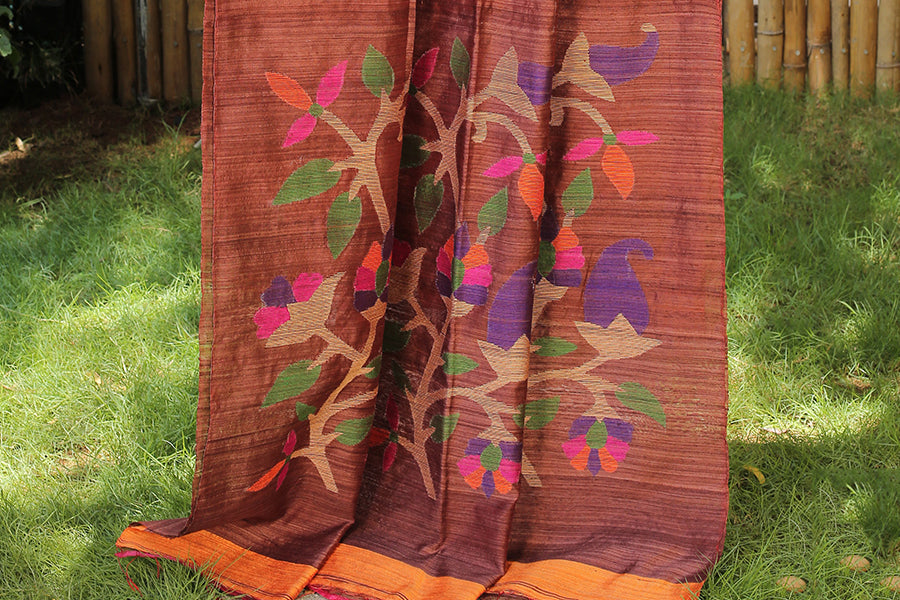Kalamkari is a beautiful art, also known as Qalamkari. It is produced in India, in the state of Andhra Pradesh. Kalamkari art form is hand painted or block printed, mostly on cotton textile. Kalam means pen and Kari mean work which means ”artwork done using pen”. It is an ancient hand drawn art mostly done using natural dyes.
Kalamkari sarees consists of gorgeous designs that depict folklore, epics or gods either hand painted or block printed. A Kalamkari saree is a product of 17 intricate steps carried out by the best craftsmen in India. Kalamkari art has been around for ages, but modern versions of these in sarees have come to the market and are in high demand today.
The History of Kalamkari
Kalamkari is one of the oldest art forms in India with a proud tradition of more than three thousand years. The art originated in various parts of Andhra Pradesh. History shows Andhra Pradesh witnessed a steep boost in trade and commerce and economic growth due to Kalamkari fabrics.
The name ‘Kalamkari’ signifies the craftsmanship on a fabric using a special pen of tamarind twig or bamboo reed rolled with wool and entwined with cotton thread. The history of Kalamkari is associated with paintings on canvas illustrating various themes from Indian mythology and it was mainly used for the purpose of narrations in street plays.
A broad classification of three styles of the art is the Srikalahasthi, Karrupur and Machalipatnam style.
Srikalahasthi style involves free-hand painting and entire colour work using the pen, incorporates sketches from Hindu mythology like Gods and Goddesses, “Krishna, rasaleela”, etc.
Machalipatnam style involves block printing art influenced by motifs of Islam culture, flowers, animals, and finishing touches are given using the pen.
Karrupur style developed in the Thanjavur district in Tamil Nadu has a profound influence of Tamil culture in its evolution. This was mostly used by Royal members of Maratha dynasty.
Colours and materials
The colours used in Kalamkari art require a special mention because all the dyes are of organic origin such as leaves, vegetables, roots and various mineral salts of iron. Though variety of colours is used, the basic ones used are red, green, yellow and black or blue. Indigo, mustard, limestone etc are used as natural colours. Jaggery, water and iron fillings are blended together to make black colour which are used to make outlines. Pomegranate peels are used to make yellow.
There is a common pattern for using the colours for various characters. For example, yellow colour is given for female characters. Evil characters are portrayed using dark colours. Gods are most often painted in blue. Black colour is used as an outline for the art.
Kalamkari on Demand
Kalamkari art being closely associated with epics such as Ramayana and Mahabaratha, many people consider wearing it as a mark of honoring our rich tradition. The fabric used for painting Kalamkari is of such high quality that even after repeated washes, the appearance and finish of the painting is not affected.
The whole process involves about 17 different steps, all contributing to the durability and attractive appearance of the fabric. The fabric to be painted is treated with cow’s milk and painting colors followed by fixing using mordant etc so as to get the desired finish.
Very keen selection of raw materials, perfection of work, organic colours used, the painstaking efforts of the artists and the lengthy and complicated procedures for the finished product justify the price of this wearable art.
The Government has given due recognition to this art form and has set up various outlets from where one can purchase genuine Kalamkari paintings. Freehand painted fabrics are always more expensive than block printed ones.
Kalamkari today
Today, Kalamkari paintings have evolved very much to suit the preferences of various classes of people inside and outside the country. The kalamkari paintings are not only employed in sarees, but also in a variety of products such as salwar materials, curtains, wall paintings, and even western outfits.
Nowadays, Kalamkari designs have great demand in national and international level. The contemporary women who love art, tradition and wish to showcase their aesthetic sense choose Kalamkari sarees.
The Indian fashion designers have worked long and hard to revive this art and create an International demand.










